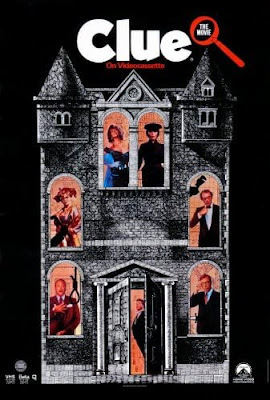A Clue or Two

Video games are hardly mything. Old-fashioned though it may be, I continue to be fond of board games,especially those that are clever or silly. From childhood onward, I’ve lovedthe Parker Brothers game, Clue. It was apparently devised in 1943 in Britain,where it was called Cluedo, and advertised as “The Great New Sherlock Holmes’Game.” I don’t know the year of my parents’ set, the one I still have, but anote at the end of the instruction pamphlet politely tells the purchaser that“any question regarding the rules of ‘Clue’ will be answered gladly if a 3 centstamp is enclosed.”
Clue, for anyone who doesn’tknow it, comes with a gameboard presenting the layout, room by room, of anEnglish country manor. There’s a ballroom, a kitchen, a conservatory, a diningroom, a billiard room, and a study, along with a few secret passageways. In myparents’ version, all these rooms are shown from above in sketch-like fashion:the billiard table once baffled me, and I decided it was a kind of very grandbathtub, with various round things floating in it. As a matter of fact thereare no bathrooms at all in this stately home, nor bedrooms, for that matter.But we’re told that poor Mr. Boddy has been murdered. The job of the gameplayers is to figure out (via the cards in players’ hands) in which room the murder occurred, and withwhich weapon (a rope? a knife? a candlestick?) And of course, who was themurderer: the dashing Colonel Mustard? The glamorous Miss Scarlett? Wise oldProfessor Plum? The dowager known asMrs. Peacock? What I’ve discovered on the invaluable Wikipedia site is that thegame has had many permutations over the years, with—for instance—England’sReverend Green turning into a middle-aged businessman, then (in the most recentAmerican editions) a handsome playboy.
I’ve been thinking about thegame of Clue ever since I saw, this past summer, a presumably Broadway-boundproduction of a stage version that is both very silly and a great deal of fun,with lots of mistaken identity and an elaborate twist ending. This new play isan homage both to the game and to a movie that came out in 1985 and is stillremembered fondly, at least by some. (Best in-joke in the play: as thecharacters are running madly from room to room in pursuit of the killer,someone says, “Who designed this house anyway? Answer: The Parker brothers.)
That 1985 movie was blessedwith a lively cast, including Eileen Brennan as Mrs. Peacock, Madeline Kahn asMrs. White, Christopher Lloyd as Professor Plum, Michael McKean as Mr. Green,Martin Mull as Colonel Mustard, and the toothsome Lesley Ann Warren as ano-better-than-she-should-be Miss Scarlett. (One of the film’s best mysteries:how does her VERY low-cut dress keep from falling down?) There’s also Tim Curry(he of the Rocky Horror Picture Show) as a complicated new character at thecenter of the plot. All seem to be having a grand old time spoofing the murdermystery films of yore. But there’s also a gimmick that sets Clue apart.Three different endings were filmed, each of which identifies a differentmurderer, with different methods and motives. Presumably, audiences weresupposed to be so jazzed by the idea of seeing variant endings that they’d showup at the cinemaplex more than once. It didn’t happen, but when the film cameout on video, all three endings were available to be seen. And some people nowregard this crazy little flick as a cult classic.
Beverly in Movieland
- Beverly Gray's profile
- 10 followers



